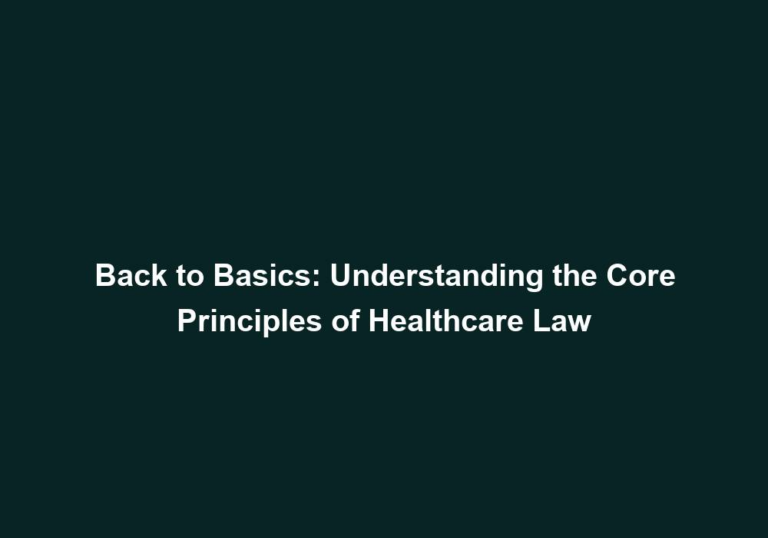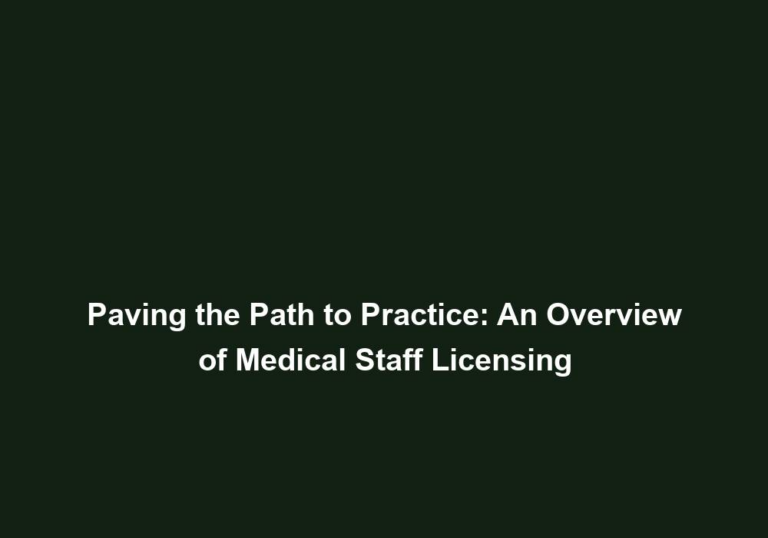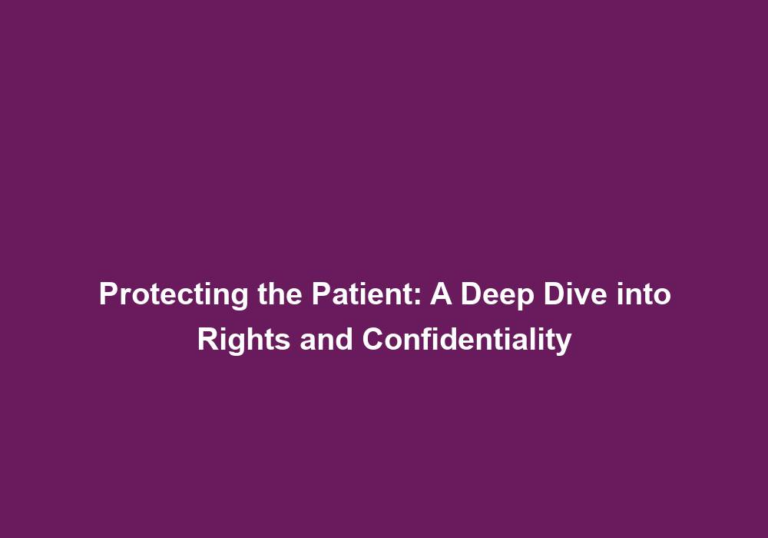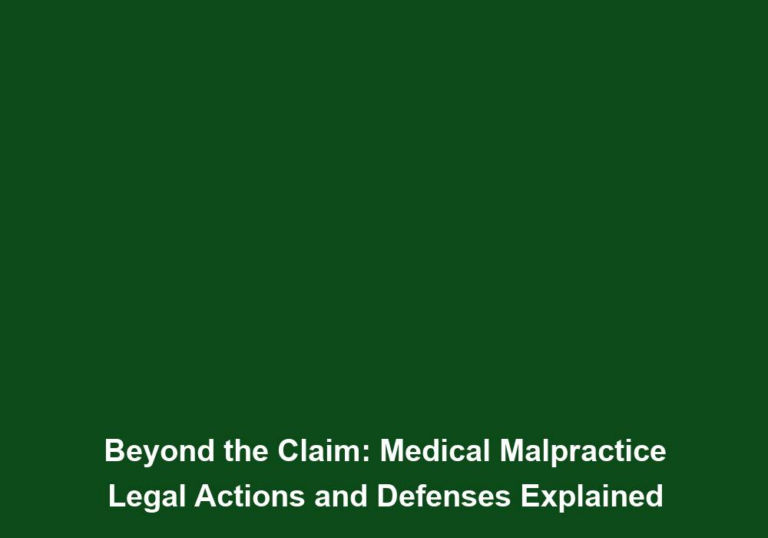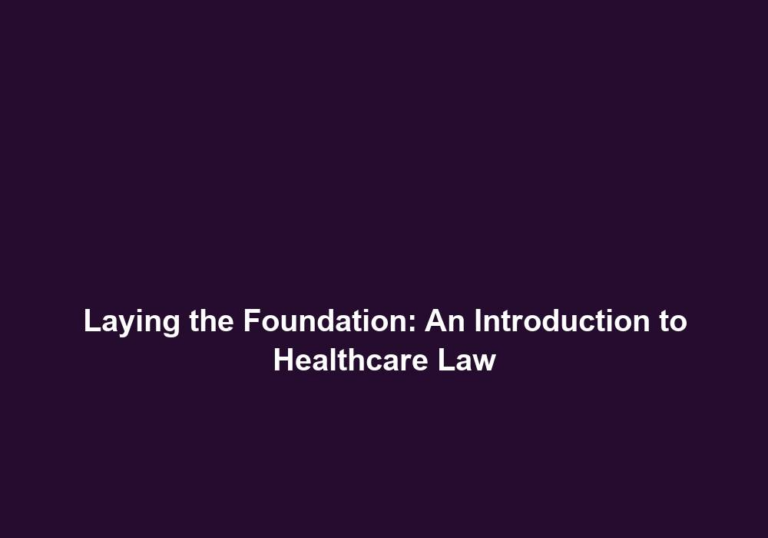Balancing Care and Caution: Understanding Medical Malpractice and Liabilities
In the field of medicine, where the well-being and lives of individuals are at stake, the utmost care and caution are imperative. However, even with the best intentions and skills, medical professionals may sometimes make errors that could lead to harm or injury to patients. This is known as medical malpractice. Understanding the concept of medical malpractice and the associated liabilities is essential for both healthcare providers and patients alike. In this article, we will delve into the intricacies of medical malpractice, its causes, consequences, and the legal obligations involved.
What is Medical Malpractice?
Medical malpractice refers to a situation where a healthcare professional, such as a doctor, nurse, or hospital, deviates from the standard of care expected in their profession, leading to harm or injury to a patient. The standard of care refers to the level of skill, diligence, and discretion that a reasonably prudent healthcare professional would exercise in a similar situation.
The Importance of Standard of Care
The standard of care is a crucial aspect of medical malpractice cases as it serves as the benchmark against which a healthcare professional’s actions are evaluated. It encompasses the knowledge, skills, and judgment that a competent professional in the same field would possess. By deviating from the expected standard of care, a healthcare professional may be considered negligent, which forms the basis for a medical malpractice claim.
Elements of Medical Malpractice
To establish a case of medical malpractice, certain elements must be present:
-
Duty of care: The healthcare professional must have had a duty to provide care or treatment to the patient. This duty is typically established through the doctor-patient relationship.
-
Breach of duty: The healthcare professional must have breached their duty of care by failing to meet the expected standard of care. This breach could occur due to negligence, errors in diagnosis, improper treatment, or failure to obtain informed consent.
-
Causation: The breach of duty must have directly caused harm or injury to the patient. It is essential to establish a causal link between the healthcare professional’s actions or omissions and the resulting harm.
-
Damages: The patient must have suffered damages as a result of the healthcare professional’s breach of duty. These damages could be physical, emotional, or financial in nature.
Establishing Duty of Care
The duty of care is a fundamental element of medical malpractice cases. It is established when a healthcare professional agrees to provide care or treatment to a patient, creating a doctor-patient relationship. Once this relationship is formed, the healthcare professional has a legal and ethical obligation to adhere to the expected standard of care.
Types of Breach of Duty
Breach of duty can occur in various ways, including negligence, errors in diagnosis, improper treatment, or failure to obtain informed consent. Negligence refers to the failure to exercise reasonable care, while errors in diagnosis may involve misdiagnosis or delayed diagnosis, leading to inadequate or delayed treatment. Improper treatment can include errors during surgical procedures, medication errors, or inadequate prenatal care. Failure to obtain informed consent occurs when a healthcare professional fails to adequately inform a patient about the risks, benefits, and alternatives of a particular treatment or procedure.
Proving Causation and Damages
Establishing causation is crucial in a medical malpractice case. It requires demonstrating that the healthcare professional’s breach of duty directly caused harm or injury to the patient. This can be challenging as there may be multiple factors contributing to the patient’s condition. Additionally, the patient must have suffered damages as a result of the breach of duty. These damages can include physical pain, emotional distress, additional medical expenses, loss of income, or even permanent disability.
Common Causes of Medical Malpractice
Medical malpractice can occur due to various reasons. Some common causes include:
-
Misdiagnosis or delayed diagnosis: When a healthcare professional fails to accurately diagnose a condition or delays the diagnosis, it can lead to delayed or inadequate treatment, resulting in harm to the patient.
-
Surgical errors: Errors during surgical procedures, such as operating on the wrong body part, leaving foreign objects inside the patient, or improper anesthesia administration, can have severe consequences for the patient.
-
Medication errors: Mistakes in prescribing, administering, or monitoring medications can lead to adverse drug reactions, overdoses, or harmful interactions.
-
Birth injuries: Inadequate prenatal care, errors during childbirth, or failure to timely respond to complications can result in birth injuries to the baby or mother.
-
Informed consent issues: If a healthcare professional fails to adequately inform a patient about the risks, benefits, and alternatives of a particular treatment or procedure, it may be considered a breach of the duty to obtain informed consent.
Importance of Identifying Common Causes
Understanding the common causes of medical malpractice can help healthcare professionals identify areas where improvements can be made to prevent errors and reduce the risk of malpractice claims. By addressing issues such as misdiagnosis, surgical errors, medication errors, birth injuries, and informed consent, healthcare providers can enhance patient safety and improve the overall quality of care.
The Consequences of Medical Malpractice
Medical malpractice can have severe consequences for both patients and healthcare professionals. For patients, it may result in physical pain, emotional distress, additional medical expenses, loss of income, or even permanent disability. On the other hand, healthcare professionals found liable for medical malpractice may face professional reputational damage, loss of license, increased malpractice insurance premiums, and potential legal actions seeking compensation.
Impact on Patients
Patients who fall victim to medical malpractice often experience significant physical and emotional suffering. They may undergo additional medical procedures to correct the harm caused, leading to further pain and discomfort. Moreover, the financial burden of medical expenses can be overwhelming, potentially resulting in a loss of income or financial instability. In severe cases, permanent disability or loss of life can occur, forever altering the lives of the patients and their families.
Impact on Healthcare Professionals
Healthcare professionals held liable for medical malpractice may face professional and personal consequences. Their reputation within the medical community may suffer, making it difficult to secure future employment or maintain a successful practice. Additionally, they may face disciplinary actions from licensing boards, leading to the loss of their license to practice. The financial implications are also significant, with increased malpractice insurance premiums and the possibility of substantial monetary damages awarded to the affected patients.
Legal Considerations and Liabilities
When medical malpractice occurs, legal remedies may be pursued to seek compensation for the damages suffered. Patients who believe they have been subjected to medical malpractice should consult with an experienced attorney specializing in medical malpractice cases. These attorneys can help evaluate the merits of the case, gather evidence, and guide the patient through the legal process.
Parties Potentially Liable for Medical Malpractice
The legal liabilities for medical malpractice may extend to various parties involved, including:
-
Individual healthcare professionals: Doctors, nurses, anesthesiologists, and other healthcare professionals directly involved in the patient’s care may be held individually liable for medical malpractice if they breach their duty of care.
-
Hospitals and healthcare facilities: Hospitals and healthcare facilities may be held vicariously liable for the actions or omissions of their staff members. Additionally, hospitals may have their own legal obligations, such as maintaining proper equipment, adequately staffing the facility, and ensuring a safe environment for patients.
-
Pharmaceutical companies: In cases where medication errors or defective drugs caused harm, pharmaceutical companies may be held liable for their role in the patient’s injuries.
Importance of Legal Recourse
Legal recourse is essential for patients who have suffered harm due to medical malpractice. It provides them with an opportunity to hold the responsible parties accountable and seek compensation for the damages they have endured. By pursuing legal action, patients can not only obtain the financial resources needed for their recovery but also raise awareness about the importance of patient safety and quality healthcare.
Preventing Medical Malpractice
Prevention is always better than cure, and the same holds true for medical malpractice. To reduce the occurrence of medical errors and potential malpractice claims, healthcare providers can take several proactive measures, including:
-
Continuing education and training: Healthcare professionals should regularly update their knowledge and skills through continuing education programs to stay abreast of advancements in their field. This ongoing learning ensures that healthcare providers are equipped with the latest information and techniques to provide optimal care to their patients.
-
Standardized procedures and protocols: Implementing standardized procedures and protocols can help reduce the likelihood of errors during diagnosis, treatment, and surgical procedures. These guidelines ensure that healthcare professionals follow a consistent approach, minimizing the risk of deviations from the standard of care.
-
Open communication and informed consent: Healthcare providers should engage in clear and open communication with patients, ensuring they understand the risks, benefits, and alternatives of proposed treatments or procedures before obtaining informed consent. Effective communication builds trust and allows patients to make informed decisions about their healthcare.
-
Effective documentation: Thorough and accurate documentation of patient encounters, diagnoses, treatment plans, and informed consent discussions can provide valuable evidence in the event of a malpractice claim. Proper documentation ensures transparency, facilitates communication among healthcare providers, and helps track the progress of patient care.
Importance of Prevention
By implementing preventive measures, healthcare providers can significantly reduce the occurrence of medical errors and potential malpractice claims. This not only protects the patients but also safeguards the reputation of healthcare professionals and promotes a culture of safety within the medical community. Prevention is a collective responsibility that requires continuous improvement and a commitment to delivering high-quality care.
Conclusion
Balancing care and caution is essential in the medical field to ensure patient safety and well-being. Medical malpractice is a serious concern that can have life-altering consequences for patients. By understanding the concept of medical malpractice, its causes, and the associated liabilities, both healthcare professionals and patients can work together to prevent and address instances of malpractice. It is crucial for medical practitioners to uphold the highest standard of care and for patients to be aware of their rights and seek legal recourse in cases of suspected medical malpractice.


